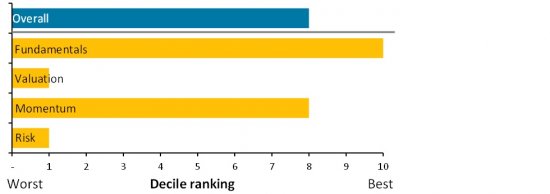Unilever Indonesia generates a 130% ROE
Unilever Indonesia generates a 130% ROE
Unilever in Indonesia generates an amazingly high level of profitability, with a return on equity (ROE) of more than 100%. What’s more, this large-cap stock has low correlation with Western stock markets, low volatility compared with other Indonesian stocks, and strong earnings momentum. My rank of “Profitable Growth” shows that the company is “World Class” when compared with 420 companies in the Consumer Staples sector across the world.
Spreading Consumer Goods and Personal Care Products throughout Indonesia
PT Unilever Indonesia Tbk (UNVR IJ, Market cap US$23.4bn) manufactures, markets, and distributes consumer goods, including soaps, detergents, margarine, dairy food, ice cream, cosmetics, tea and other drinks and fruit juice. Home and Personal Care contributes 71% to its revenues, while 29% is brought in by its Foods and Beverages division. The company is 85% owned by Unilever NV.
Figure 1: Share Price and Valuation
What I Like About it
UNVR has improving asset turnover relative to companies across the region, low correlation with Western stock markets and a share price that is less volatile relative to companies in Indonesia. The company dominates 13 out of 14 segments it operates in, holding more than 50% market share in areas such as facial, hair, oral care goods and ice cream. One of its subsidiaries, Unilever Oleochemical, is to open its palm oil processing plant in North Sumatra in the first half of 2015, with 20% of output set aside for UNVR, which will reduce the company’s production costs and FX risks.
Unilever Indonesia delivers an amazingly high 100%+ ROE and has a solid balance sheet. The main risks are that higher inflation in Indonesia limits consumers’ buying power, palm oil and raw material costs rebound, or that there are more delays in the construction of the railway being built to serve its oil plant.
Where is the Company Going?
Two-thirds of UNVR’s revenue comes from home and personal care products, with the rest coming from food and refreshments. The company offers home care and hygiene products in the fabric cleaning and care area, oral and household care groups that are embodied by the high-profile brands Rinso, Molto, Pepsodent and Sunlight.
It has Personal Care brands in the daily hair care, mass-market skin care, and deodorant product ranges that include Axe, Ponds, Dove, Clear, Sunsilk, Lifebuoy and Rexona. It also delivers Food and Beverage brands such as Lipton Tea, Wall’s ice cream, and Buavita juices.
The more than 40 brands owned by Unilever are sold through 500 independent distributors across Indonesia and its own centers, satellite warehouses, depots and other facilities. It also operates a Personal Care factory in East Java and a Food and a Home Care factory in Central Java. In addition, it supplies tea, soap, toothpaste, and skin products to New Zealand, Australia, and Asia, Africa and Latin America.
Unilever’s upcoming Sumatra plant is to turn palm oil into oleochemicals, vital raw materials to produce detergents, solvents, and biodiesel. Since the “mad cow” disease scare, it has become even more important to replace tallow, an animal fat used in lubricants and waxes.
Leadership and Ownership
As an Indonesian company, Unilever has a “Two-tier board system”, different from what we are familiar with in the west. There are six members of the Board of Commissioners, and nine members of the Board of Directors. The Board of Commissioners is similar to what is called a board of Board of Directors in other countries.
The management team in an Indonesian company is called the Board of Directors. UNVR is run by its President Director Hemant Bakshi, an Indian citizen. The company is relatively tightly held, though it is large enough to have about US$5bn in average trading volume.
Four Elements: FVMR
When compared to 3,660 non-financial companies in Asia, UNVR is rated the best on fundamentals, with a 130% ROE and a 43% ROA. Such a massively profitable business does not come cheap, and its valuation is very, very expensive at 47x PE and 58x PB (Yes, that’s right! Its price-to-book ratio is higher than its price-to-earnings ratio). So, a value investor may not be interested in such a stock, but a momentum investor may like its strong earnings momentum. Finally, risk is relatively high in my model, as the company has a high beta and low current ratio. The latter is due to exploiting supplier credit, accounts payable accounts for more than half of the company’s current liabilities.
Figure 2: Attractive on Fundamentals and Momentum, not Valuation and Risk
 Profitable Growth: World Class
Profitable Growth: World Class
My rank of “Profitable Growth” shows that the company is “World Class” when compared to 420 companies in the Consumer Staples sector across the world, reaching the top decile in my combination of ROA and EPS Growth, or what I call “Profitable Growth”.
Figure 3: A ‘World Class’ Company Based on ‘Profitable Growth’

Source: A. Stotz Investment Research. Notes: 1 = top ranking and 10 = worst. PTM=Past 12 months of published data.
Do you use ROA or ROE? Why do you prefer one over the other? I would love to hear your thoughts! Any comments or question you might have, I would like to know. Is anything unclear? Please let me know in a comment below.
References:
More info about the company can be found here.
More info about the “Board of Commissioner” company structure in Indonesia can be found here.
DISCLAIMER: This content is for information purposes only. It is not intended to be investment advice. Readers should not consider statements made by the author(s) as formal recommendations and should consult their financial advisor before making any investment decisions. While the information provided is believed to be accurate, it may include errors or inaccuracies. The author(s) cannot be held liable for any actions taken as a result of reading this article.
Originally published on May 26, 2015 at: www.equities.com.



